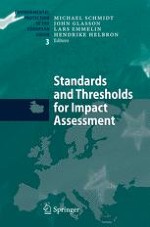Standards and Thresholds play an important role in many stages of the Environmental Impact Assessment (EIA) process. They can be legally-binding or guidance values and are linked to environmental data. This publication provides a comprehensive collection of standards and thresholds, their derivation and application in case studies of EIA projects. The first part introduces the nature of standards and thresholds and key drivers for their determination. The book then describes, in Part II, technical standards from the perspective of EIA projects. Part III addresses the issue from the other side, environment and human health, and discusses the assessment of impacts on the sensitivity or value of environmental and health components. Part IV sets out some emerging issues for standard and threshold with reference to new sectors and with recent instruments. The book concludes in Part V with the role of monitoring, and final implementation.
